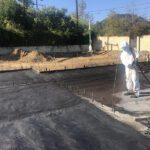Hancock Park School – Methane Gas
Hancock Park Elementary School is located in the Fairfax District of Los Angeles. Commercial properties such as the large Park La Brea apartment complex and the Fairfax Area Mall surround the school campus. Infamously the Historical Oil fields surround the school. Faculty at Hancock Park aim to provide a comfortable and enriching learning environment for their students. To accomplish this goal, the Friends of Hancock Park School conducts fundraising activities, seeking grants and corporate donations to provide more for the students.
The funds, grants, and donations can support each classroom and staff member. They also plant and maintain their school farm, which provides significant learning experiences for the children, considering that their school is in the middle of the city. Hancock Park has a Native Garden wherein students study plants and insects. This experience enhances their knowledge and provides a community experience. Hancock Park Elementary School wants to improve the irrigation of the trees in their Native Garden.
Methane Soil Gas and Hancock Park School
A month after the 1985 Ross Store methane explosion, officials of the Los Angeles Unified School District detected high levels of methane soil gas under the nearby playground of Hancock Park Elementary. According to the School Safety Supervisor, a methane explosion is unlikely because the gas was not migrating. Nor was gas trapping inside the school building and rapidly dissipating in the open air.
However, this raised concern for the other schools in the area, especially those located near landfills and oil fields. This concern led to the district officials’ announcement of methane testing, surveying, and monitoring of 181 school sites. School officials had to conduct methane testing in each school by drilling holes in the ground and inserting hand-held probes to measure gas levels.
Methane testing was necessary because methane gas will be explosive if the high methane concentrations are oxidized by air and exposed to an ignition source. This is what was believed to have happened in the 1985 Ross Store Methane explosion. Methane gas seeping from below the earth became trapped in the store’s basement and was ignited by an electric spark. The blast caused injuries and damage to the interior and exterior of the building.
Through methane testing, high levels of methane gas were detectable in the Hancock schoolyard but not inside or under the school building itself. It turns out that the native soil within the park was more prone to Methane seepage while the soil beneath the structure resisted methane migration.
What was the source of methane gas?
The source of methane gas was unclear, though. The initial 1985 Ross Store explosion report determined two possible origins—a shallow source organic origin and an oil field origin. At first, belief of the origin of methane gas was the abandoned oil wells in the Fairfax district. The task force reports show that this was improbable because gas formation was above the production zone. A 1989 methane gas venting in the area, which included forceful ejection of water and mud, also made the origin of the methane gas more complex.
Despite the confusion, the task force concluded that although knowing the origin aids in the understanding of the problem, it does not matter when it comes to protecting buildings from methane gas seepage. The ultimate goal would be to limit or control methane gas migration by utilizing a gas vapor mitigation system. https://web.stanford.edu/~meehan/la/pubs/pubross.pdf
Just recently, on February 8, 2015, a small methane explosion occurred near the corner of Wilshire Blvd and Curson, just across from the La Brea Tar Pits. A methane leak caused it due to the substantial methane gas releases and build-up in the area. More recently, a gas leak in the same area was initially suspected to be natural gas. However, it was determined that the gas buildup was caused by the methane from the La Brea Tar Pits.
How to Prevent Methane Gas Hazards
Aside from being potentially explosive, the buildup of methane gas in an enclosure such as a school building or a residential home can lead to asphyxiation due to oxygen deprivation. To prevent, at the very least, control these methane gas hazards, an extensive methane mitigation process that requires an in-depth overview and knowledge becomes necessary.Methane Gas Vapor Mitigation is implemented specifically in basement walls and the foundation. The concrete slab cannot provide enough protection from methane vapor intrusion. Methane gas vapors can migrate through walls due to the concrete cracks, pressure, and concentration.
Methane Mitigation Process
The methane mitigation process includes installing a methane barrier, which is one of its key components. The methane barrier is an impermeable membrane that acts as a seal for the concrete slab. It’s installment goes below the foundation of a structure. This membrane installs to decrease the amount of migration of methane gas vapor.
Because of the urgency to come up with a solution after the destructive 1985 Ross Store methane explosion, Methane Mitigation Engineers wanted to implement a methodology that involved the design and construction of a sealant beneath the foundation of structures to ensure that no methane nor other harmful gas could penetrate a foundation.
To execute this plan, Gas Vapor Intrusion Consultants wanted to utilize products that were already tested, proven and had decades of proven field data. They saw the potential for gas vapor mitigation in waterproofing products.
To validate this hypothesis, a licensed LADBS Testing Agency tested these preexisting Waterproofing Membranes for use as a Methane Barrier. Methane Test Results showed that some waterproofing products like spray-applied asphalt emulsions slowed down the mass diffusion of methane. Methane consultants and LADBS collaborated to develop the first specifications for methane barriers. This was the most efficient solution. Given that creating an entirely new methodology for methane mitigation would take too much time.
Components for Methane Mitigation
Methane Gas Hazard Engineers had to establish the LADBS Methane Mitigation Standard Plans. Which define a system with Methane detectors, Methane alarms, and Lowest Level Methane Ventilation fans in areas with high-risk methane gas intrusion. The LADBS Methane Mitigation Standard Plans, which outline the current LADBS requirements for succeeding construction projects.
Methane Alarms and Methane Sensors are necessary for the continuous monitoring of the concentrations of methane. If concentrations reach a certain level, the active alarm system will get a trigger. This is to notify occupants of the possible Methane Hazard. These will be installed in the subsurface areas and the lowest space of the building.
The sub-slab vent system must be implemented to decrease the mass diffusion rate of methane gas. Highly concentrated and pressurized gas vapors will naturally migrate into an area with less concentration. The sub-slab vent system will depressurize the subfloor by directing the methane gas flow through the vents. Rather than into the structure, ultimately reducing the mass diffusion rate.
This system includes exhaust fans and/or blowers, a perforated pipe, and a gravel blanket. These all install below the surface of the building. The sub-slab vent system also provides relief in the case of an obstruction on the membrane. This system needs to be designed by a licensed professional engineer who has experience designing methane depressurization vent systems.
To ensure methane mitigation is correct, the design and materials to implement for the construction must meet the LADBS standards. A licensed Methane Mitigation Contractor must be consulted for the methane mitigation construction. Also for the verification of the foundation seal’s security to prevent further methane vapor intrusion. A Methane Deputy Inspector also has to oversee and approve of the installation during the construction.


